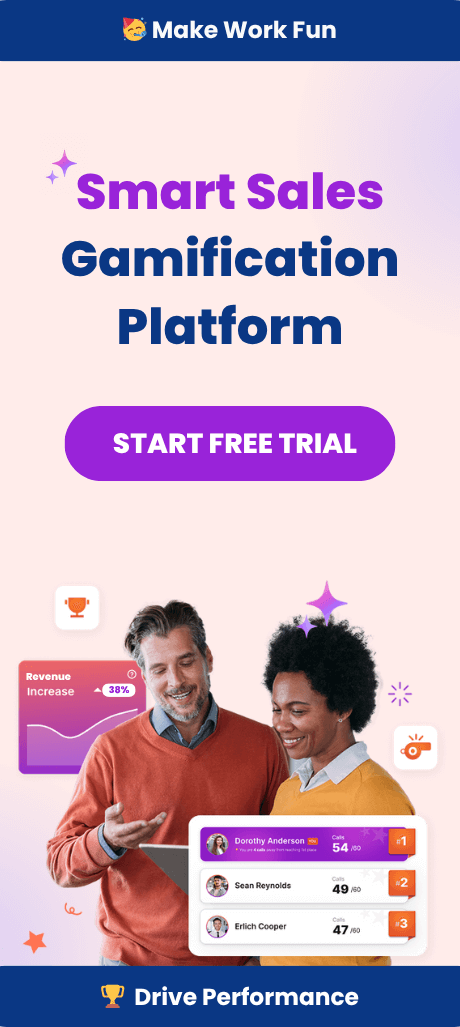Sales leaders are continuously seeking strategies that inspire consistent achievement and create lasting engagement. While digital leaderboards have long been a staple of sales culture, the narrative that surrounds them is changing. Once seen as mere tools for tracking numbers or sparking fleeting competition, leaderboards now sit at the center of performance culture, influencing motivation, collaboration, and organizational health. In this article, we reconsider the impact of leaderboards, unpack their evolving role in team engagement, and explore how they can propel enterprises toward more sustainable success.
The New Purpose of Digital Leaderboards
There was a time when leaderboards simply displayed rankings—high versus low, winners versus losers. That narrow focus often produced transient spikes in energy, followed by inevitable dips in morale. Sales VPs and Enablement Leads began to question: If half the team slips into disengagement once they fall behind, are leaderboards truly furthering our collective objectives?
Modern leaderboards are informed by a more strategic philosophy. Today’s executive audience recognizes that public data visibility alone is not a universal motivator. Instead, a new generation of digital leaderboards is designed to:
- Foster continuous feedback, offering each team member meaningful insights regardless of their current rank
- Encourage peer-to-peer recognition, transforming the leaderboard from a source of stress into a platform for support
- Highlight collaborative goals, not just individual competition, driving alignment with broader business KPIs
This approach draws on industry learning, emphasizing inclusivity, individual growth, and actionable data—all critical requirements for engagement in today’s distributed, digital-first workplaces.
From Numbers to Narrative: Humanizing Performance Metrics
It is essential to foreground the “why” behind the metrics displayed on digital leaderboards. Executives understand that raw numbers tell only part of the story. The true value lies in contextualizing these metrics: What does a particular placement mean for a rep who just onboarded last quarter? How does comparing team performance reveal coaching opportunities, or areas for support?
Recent advancements allow sales teams to use customizable leaderboards where performance categories go beyond closed-won deals and can track activities like call quality, pipeline growth, or even cross-functional collaboration. By curating which data is celebrated—and how—it becomes possible to humanize every achievement rather than simply tallying wins.
Insights in Action
Focusing on context, not just counts, is a lesson championed by leading firms. Take the approach outlined in Customizable Leaderboards Drive Engagement—by segmenting leaderboards to recognize varied contributions, organizations nurture specialists and generalists alike, reducing burn-out and raising the collective standard. Ultimately, leaderboards become more than digital billboards. They enrich team storytelling, making success visible and personal for every contributor.
Leaderboards and Psychological Safety
Culture and engagement theorists have long cautioned against the risk of turning leaderboards into sources of anxiety. In their early iterations, leaderboards sometimes fostered zero-sum thinking—if you win, I lose. However, a data-driven and psychologically informed approach highlights a better alternative.
- New digital leaderboards incorporate anonymous modes for self-tracking progress, supporting learners who thrive outside of public scrutiny
- Goal tiers allow individuals to celebrate incremental progress, not just elite achievement, creating space for everyone to succeed.
- Team-based leaderboards channel competitive energy into shared outcomes—think overall quarterly targets or new initiative participation rates, strengthening the social fabric of the group
By building psychological safety into performance visibility, companies empower even risk-averse or newly onboarded team members to participate, contribute, and improve over time.
The Customization Imperative
Executive teams increasingly recognize that no two sales cultures are identical. The shift to customizable leaderboards is not just a feature upgrade—it is a business necessity. Configurable ranking methods, category weighting, and the ability to spotlight “most improved” contributors equip VPs and RevOps Directors to align competitions directly to company values and evolving goals, rather than defaulting to legacy models.
For more on the transformative impact of customization, see the findings in Why Customizable Leaderboards Inspire Sales Teams. The ability to surface micro-competitions and collaborative challenges reinforces positive behavioral changes across departments. As a result, leaderboards become a living component of company strategy, not a static scoreboard.
Engagement: Beyond Rankings
Modern workforce research demonstrates that engagement rises when individuals feel both recognized and empowered. Digital leaderboards that embed “shout outs,” badges, or team-based milestones translate recognition from a quarterly awards ceremony to an everyday experience. This real-time feedback can catalyze immediate action, mitigate mid-month slowdowns, and keep motivation high even during routine cycles.
The relationship between digital leaderboards and ongoing engagement is especially evident in distributed or hybrid sales teams. Public celebration—whether via digital signage, live dashboards in common rooms, or even acknowledgment within Microsoft Teams integrations—bridges the isolation that comes from remote work, cultivating a sense of unity across distance.
Data-Driven Coaching and Continuous Improvement
Effective sales coaching relies on timely, actionable data. Digital leaderboards serve as central repositories for performance metrics, enabling managers to detect trends and proactively support team members. Rather than waiting for quarterly reviews, sales managers can identify high-potentials, coach up-and-comers, and intervene with those at risk of disengagement as soon as evidence arises.
As referenced in Sales Coaching Best Practices for New Managers in 2025, the integration of digital leaderboards with CRM and other sales enablement platforms creates a feedback loop between individual activity, observed output, and tailored coaching plans. In this context, leaderboards act as both compass and motivator, ensuring that efforts align to business-critical outcomes.
Promoting Inclusion and Redefining Achievement
Not every high-impact player shines in traditional sales categories. Progressive organizations are using digital leaderboards to spotlight unexpected forms of excellence: the rep who mentors new hires, the team that pilots new tools, or the member who consistently collects and shares customer insights. Expanding what is measured and rewarded creates a culture where more people can identify with success.
In Why Gamification Reinvigorates Company Culture, the focus on acknowledging diverse contributions is shown to increase employee satisfaction and retention. The message is clear: When achievement is multi-dimensional, engagement broadens and so does performance consistency.
Integrating Digital Leaderboards with Sales Gamification
Leaderboards are foundational to a robust sales gamification strategy. Platforms like Spinify enable organizations to embed leaderboards directly into daily workflows, creating dynamic, real-time competitions, and surfacing progress visually throughout the workday. The marriage of gamification and digital leaderboards encourages both fun and focus—qualities that drive ongoing results.
More so, gamified leaderboards encourage reflective behaviors. For instance, celebrating “personal best” streaks or new skills learned incentivizes improvement in nuanced ways, especially when compared to systems that fixate solely on final numbers.
The Board as a Tool for Alignment
Leaderboards offer more than just engagement—they can be leveraged to align frontline activities with organizational vision. Through quarterly themes, cross-functional team contests, and ever-adjusting ranking logic, digital boards serve as a living reinforcement of strategic priorities.
- Monthly leaderboards can emphasize revenue for growth stages, or customer retention for maturing markets
- Spotlights can shift throughout the year—from lead generation to customer satisfaction—adjusting incentives to match evolving business needs
- Leadership can use patterns from leaderboard data to guide conversations in team meetings, recognizing both top performance and meaningful improvement
These integrations convert abstract strategy into daily practice, making organizational vision tangible and measurable for all participants.
Overcoming Common Leaderboard Pitfalls
Executives and enablement leads know that digital leaderboards are only as effective as their underlying design. Pitfalls including overemphasis on winner-take-all logic or static configurations that ignore team heterogeneity can stifle engagement as quickly as a well-run board can spark it. To maximize value:
- Regularly refresh categories, metrics, and incentives so the board evolves alongside the business
- Solicit feedback from every segment of the team—junior and senior, on-site and remote—to ensure no participant feels left behind
- Audit leaderboard impact quarterly, measuring not just outcomes but also sentiment through surveys or one-on-ones
For a deeper dive on steering clear of common engagement missteps, reference Leaderboards Done Right: Avoiding the Pitfalls of Sales Competitions.
Leadership in the Age of Transparent Performance
The rise of digital leaderboards places new responsibilities on executive and team leadership. Instead of passively observing data, today’s leaders are challenged to interpret trends, coach in real time, and use leaderboards as a means for career development rather than mere scorekeeping. This shift requires a nuanced approach—balancing competitive drive with empathy and recognizing that leadership is ultimately about lifting the entire group.
For CEOs and senior managers, leaderboards also offer a unique opportunity: visibility into the health of both processes and people. By observing lagging indicators early, they can adjust resourcing, offer targeted development opportunities, and maintain high morale across fluctuating market conditions.
The Future: Interactivity and Real-Time Engagement
The next phase of digital leaderboards brings interactivity to the forefront. Expect greater integration with communication platforms (like Slack or Microsoft Teams), AI-driven pattern discovery for equitable recognition, and mobile access for on-the-go teams. Instant feedback and gamified nudges keep progress visible and relevant amidst all other technology distractions.
For organizations seeking to future-proof their sales engagement, trialing a digital leaderboard solution such as Spinify can illuminate the right configuration for their unique culture. Try customizable leaderboards to experience first-hand the difference that thoughtful design can yield in sales energy, engagement, and achievement rates.
Conclusion: Moving Forward with Purpose
Leaderboards have come a long way from simple public rankings. In their modern, digital incarnation, they drive meaningful engagement, illuminate diverse paths to success, and serve as living expressions of company culture. Executives who understand their transformative capacity will not only boost short-term numbers but also unlock enduring performance and loyalty. The challenge now is to embrace the adaptability and inclusivity that today’s workforce demands, turning every leaderboard into a catalyst for strategic, people-first achievement.



